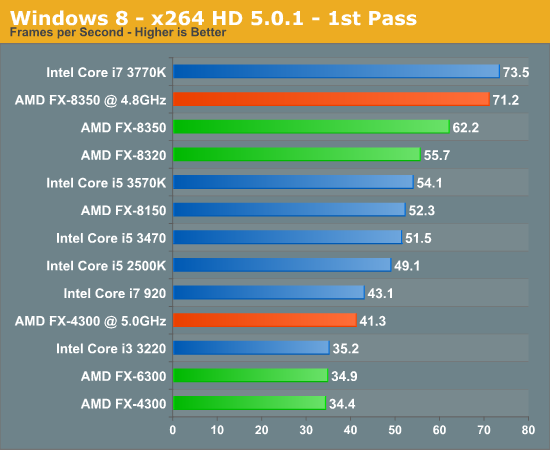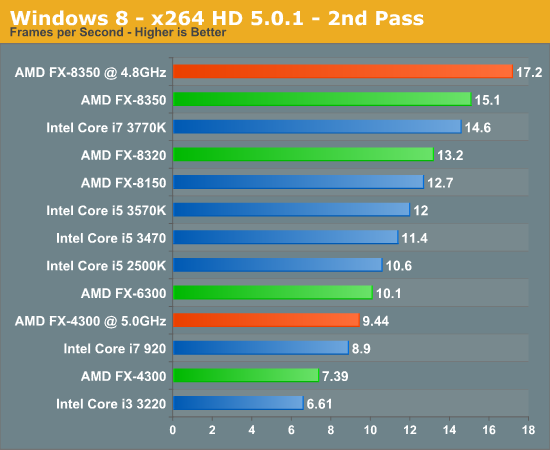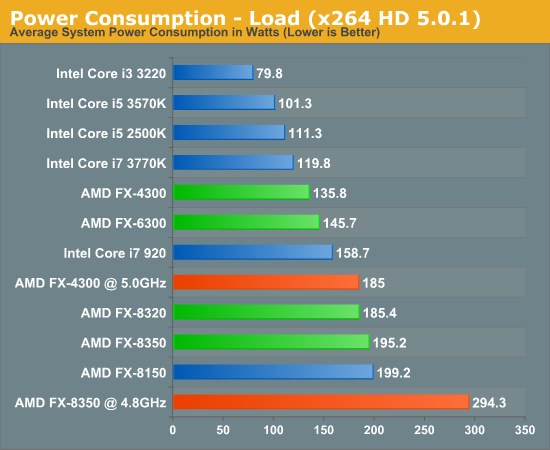The Vishera Review: AMD FX-8350, FX-8320, FX-6300 and FX-4300 Tested
by Anand Lal Shimpi on October 23, 2012 12:00 AM ESTOverclocking
AMD's FX architecture was designed for very high clock speeds. With Piledriver we're able to see some of that expressed in overclocking headroom. All of these chips should be good for close to 5GHz depending on your luck of the draw and cooling. For all of these overclocking tests I used AMD's branded closed loop liquid cooler which debuted back with the original FX launch. I didn't have enough time to go through every chip so I picked the FX-8350 and FX-4300 to show the range of overclocks that may be possible. In my case the FX-4300 hit 5GHz with minimal effort, while the FX-8350 topped out at 4.8GHz (I could hit 5GHz but it wasn't stable through all of our tests). Both of these overclocks were achieved with no more than 10% additional core voltage and by simple multiplier adjustments (hooray for unlocked everything). The increase in performance is substantial:


The increase in power consumption is pretty bad however, you do pay for these types of voltage driven overclocks:

The 5GHz FX-4300 is pushed into FX-8300 territory, while the 4.8GHz 8350 is in a league of its own at just under 300W of total system power consumption.










250 Comments
View All Comments
coder111 - Tuesday, October 23, 2012 - link
Now what I'd like to see is how many of these benchmarks are compiled with intel compiler. In case you don't know yet, Intel Compiler disables a lot of optimizations if you are not running a Genuine Intel CPU, even if your CPU supports required features and would benefit from these optimizations. In other words, anything compiled with intel compiler will run slower on AMD cpus just because of Intel compiler.Now you can argue that this is a reflection of real performance on Windows, as in Windows quite a few of DLLs are compiled with Intel Compiler as well.
What I'd like to see is some more benchmarks for Linux operating system and/or professional software. Things like data base servers (including something non-Microsoft, like PostgreSQL or MySQL), java application servers, GCC compiler benchmarks, apache/PHP server, virtualization, python/perl/ruby, LibreOffice/OpenOffice productivity.
Now, back to Vishera. This looks like a nice CPU. I haven't been CPU bound in my work for a while now, so performance wise this would be sufficient for my needs. What I'd like to see however is lower power consumption. Unfortunatelly I don't see that coming until Global Foundries minimizes their process...
CeriseCogburn - Tuesday, October 30, 2012 - link
So amd has abandoned gamers on the cpu side.Good to know.
Blibbax - Tuesday, October 23, 2012 - link
The dragon age origins graph has the 8150 in blue and no i3.Blibbax - Tuesday, October 23, 2012 - link
SC2 and WoW also.dishayu - Tuesday, October 23, 2012 - link
7zip as wellBlibbax - Tuesday, October 23, 2012 - link
"As I mentioned earlier however, this particular test runs quicker on Vishera however the test would have to be much longer in order to really give AMD the overall efficiency advantage. "If you think about it, efficiency is unrelated to length of test.
CeriseCogburn - Tuesday, October 30, 2012 - link
He was talking about electrical usage vs work done, hence with amd's higher per second use of electricity, it must complete the test MUCH faster than Intel in order to win that.It completed faster, but not fast enough to use less power.
This lesson is over for amd.
iTzSnypah - Tuesday, October 23, 2012 - link
In price per performance. A 125w part beating a 67w (Not sure about that figure) will cause Intel to keep the same TDW for 2014 and just have a 35-40% performance increase. I can only hope.CeriseCogburn - Tuesday, October 30, 2012 - link
If you're used to running or servicing Intel cpu's then you pick up the LEAD WEIGHT that is the modern AMD cpu, all that HEAT SINKING comes to mind.I mean they are just honkers. You pick it up and it's like what the heck !?
meloz - Tuesday, October 23, 2012 - link
I wish Anandtech would include some form of value scatter graphs like Techreport does in its reviews. The graphs do not have to be an exact imitation of what Techreport does, and the benchmark(s) used to determine the 'overall performance' can be different. Perhas we could even get performance per watt per dollar graphs.Graphs like these make the whole exercise of comparing competing products so much more relevant to users, because most of us will buy the most performant processor per dollar.
As example:
http://techreport.com/r.x/amd-fx-8350/value-scatte...
http://techreport.com/r.x/amd-fx-8350/gaming-scatt...
This is, of course, considering the result without any attention to performance/watt. If you include power consumption in the calculations at all, Intel is an easy choice.
Difficult to see how AMD will cope with Haswell, even if they get another 15% boost next year. The gap in performance / watt only seems to be diverging, Intel taking a commanding lead.